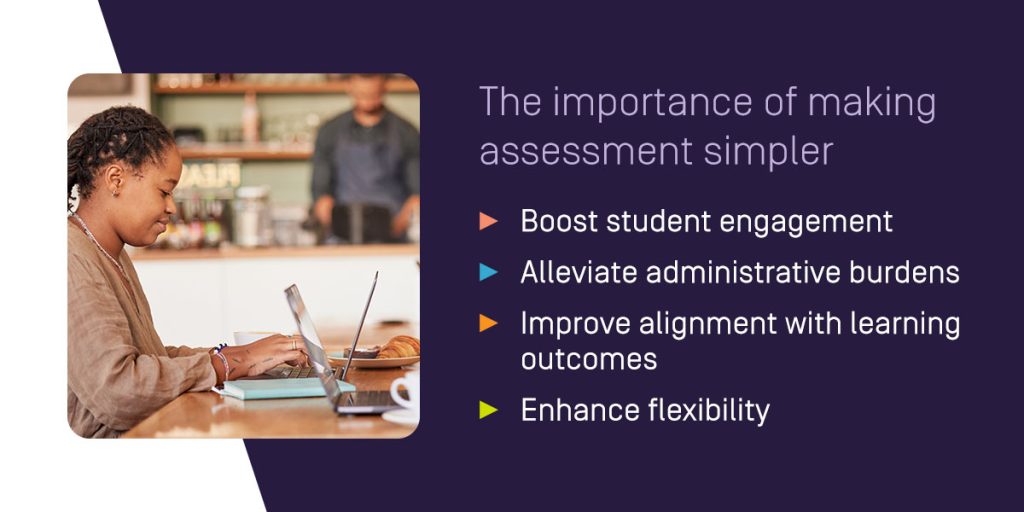




The assessment process can often feel like a chore, particularly when faculty feel like they’re doing double work by grading students on their coursework and then spending additional time on assessment reporting.
Creating common performance indicators so that all faculty measure in the same way can also be challenging. For example, one faculty member’s 3 on a rubric can be another instructor’s 5, creating inconsistency across campus. So, how can you make the measurement process easier?
When a higher education institution makes assessment simpler, it can supercharge its efforts to improve. Explore the benefits of straightforward assessment:

Colleges and universities can implement various changes to make assessments less complex. By taking steps to create simpler strategies, your institution can take advantage of a more impactful, engaging, and effective experience.
Check out these helpful suggestions for how to simplify assessment:
The goal of assessment isn’t to overhaul your programs or curriculum (although that can happen). Your goal is to make sure your institution is achieving its mission. Don’t worry about getting too granular in your measurement efforts. Instead, focus on measuring the most important things first — what matters most to your institution and your students.
Your primary goals will guide important decision-making and help your college or university stay grounded in its overarching mission.
Spend the time upfront to create centralized assessment instruments so that expectations are apparent from the start. Clearly define your outcomes and identify objective ways to measure progress and results with validity and reliability in mind.
Assessment instruments may include:
Figure out the best way to measure how students are performing, and create clear definitions of success. Rubrics are very helpful in reducing subjectivity in scoring, and you don’t have to start from scratch in developing your own.
A basic grading rubric includes criteria, performance levels, scores, and descriptors. They standardize grades and take the bias out of evaluating student learning outcomes.
By circulating assessment data widely (and frequently), faculty can see their impact on the assessment process and why their work matters. The valuable insights in these reports help improve course quality, enhance the learning experience, and make it possible to pivot quickly if needed.
The key to acting fast and improving assessment efficiency is keeping your stakeholders on the same page with timely updates and open communication.
Curriculum mapping and activity maps help surface the most important courses and artifacts, which are the ones you should pay attention to. By staying focused, it’s easier to create a clear, shared understanding across the organization of what you’re trying to measure and how best to assess student learning.
Ideally, your measurements will stay as consistent as possible each term so that you can gather longitudinal data and analyze trends. But it’s also important to consistently evaluate your measurement strategy to make sure you’re collecting the best possible data. Pay attention to results and action items from the measure, and if you’re seeing issues, consider making a change.
If you’re seeing an area that needs improvement, be thoughtful about adjustments. By measuring the most important items first, you’ll be able to see when an outcome requires more coverage in the coursework or when outcomes need to be adjusted to align with changes outside the classroom. These changes may include:
Assessment software for higher education is built based on best practices and accreditor requirements, which means a lot of the heavy lifting is done for you. If you implement the tool and work within its templates and structure, you’ll spend less time designing and managing your process and more time applying the insights that come from the data.
The right tools are integral to streamlining the entire assessment process from start to end. They make it easy for your institution to harness the power of automation, data, and reporting in a centralized hub.

If your college or university is interested in streamlining assessment, turn to Watermark. We have more than 20 years of experience providing higher education institutions with the software solutions they need to drive continuous improvement and meaningful change.
With Planning & Self-Study, your institution can centralize planning, assessment, and outcomes data in a single, integrated hub. We’ll help you manage assessment planning and increase data transparency to elevate your operations.
Ready to learn how your college or university can simplify assessment processes and take advantage of our full suite of solutions? Request a demo of the strategic planning and accreditation software from Watermark today.





























































































































































































































































































































































































